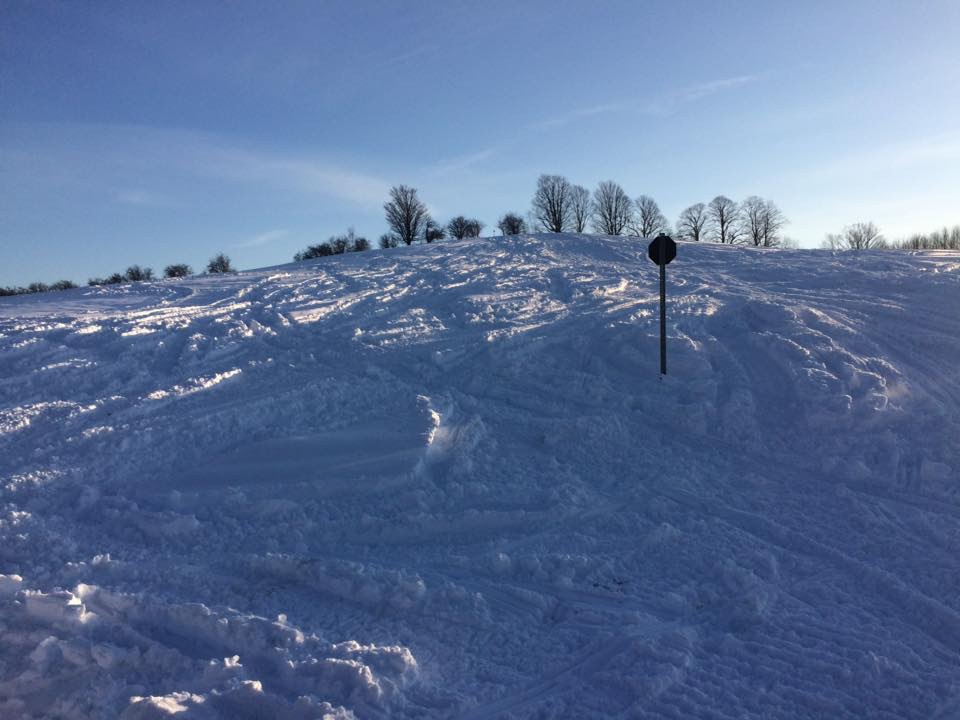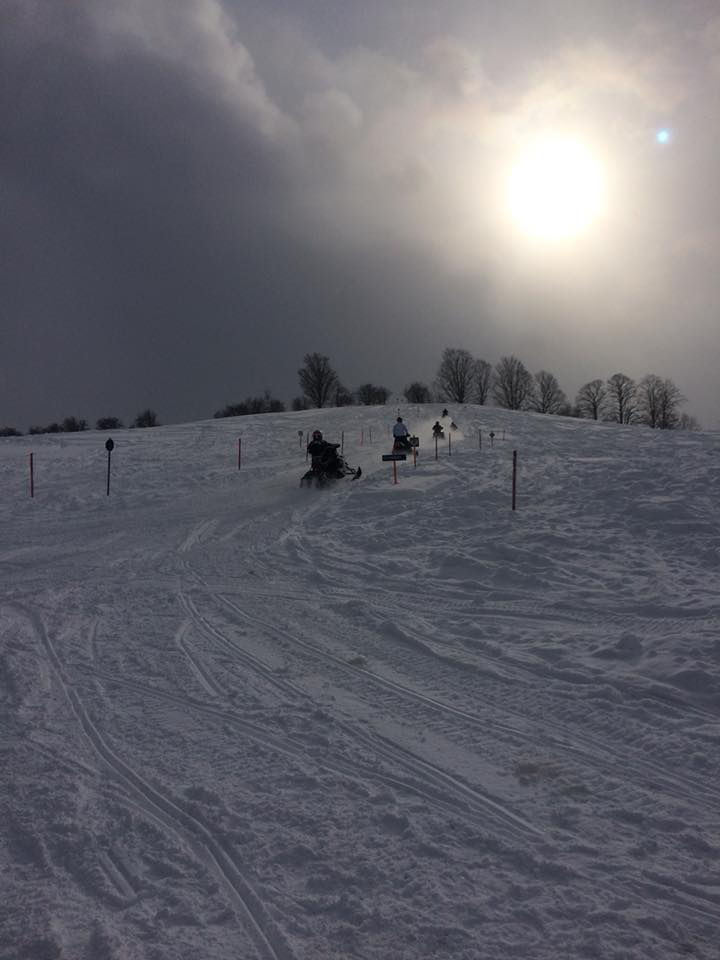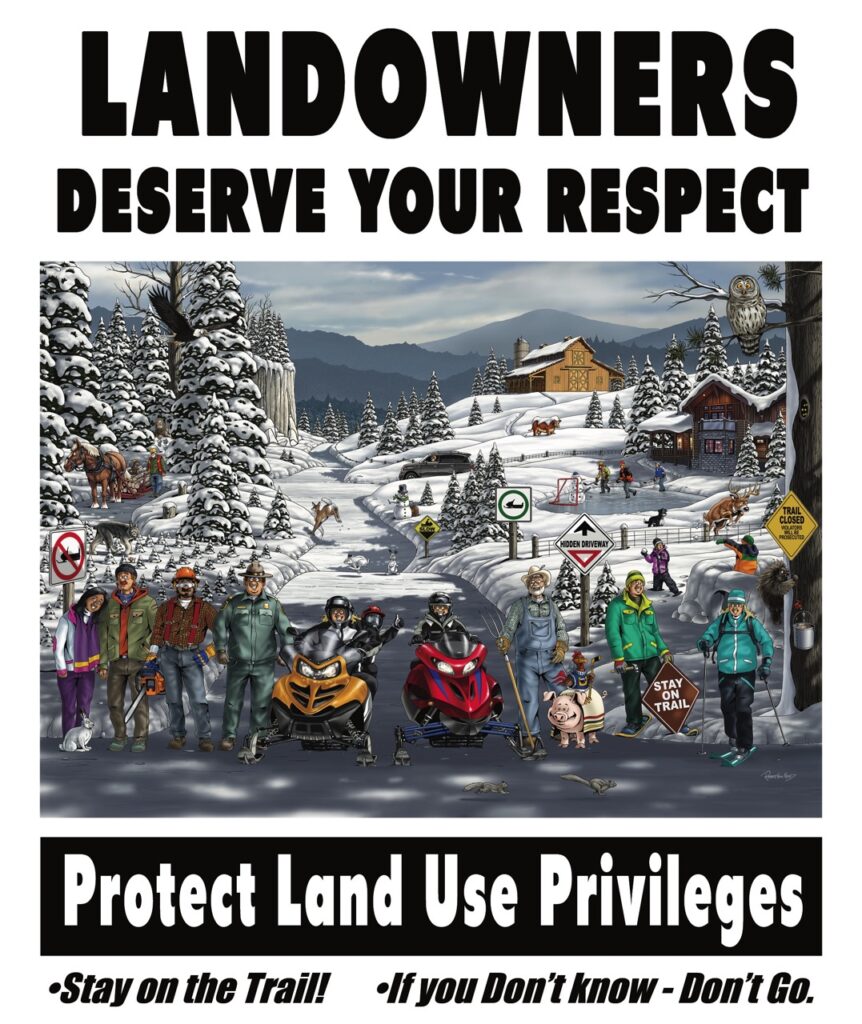Declaring War On Riders Who Cause Trail Closures…
Related: Why Trails Don’t Open Early
Enough pussyfooting around. I’m really pissed off. I’m fed up with the “I-can-go-anywhere-I-want” mentality of some snowmobilers and how it’s hurting our favourite winter activity…
It’s a growing problem for trail riding areas across North America. Trails closing because riders won’t stay on designated corridors. Riders wandering off the marked trail to track fresh powder, to cut a corner or to take a shortcut. Whatever their reason, the consequences of leaving a marked trail are slowly killing the winter recreational activity we love with a death by a thousand cuts. And it will be over before we realize what happened.
One problem is that too many of us take organized snowmobile trails for granted. For most of today’s riders, snowmobile trails have always been there. With the cooperation of Old Man Winter, snowmobile trails are just available to ride each and every winter.

We’re seeing way to many closures like this! Photo sourced from a Facebook post.
They appear as if by magic and few snowmobilers really appreciate the massive, behind the scenes effort to keep them happening over and over again. Small wonder, when less than 10% of Ontario riders volunteer for their local club. Those that do quickly discover just how hard it is to keep trails in place. Much less to try to replace closed ones. In fact, this declining volunteer rate may also be a reflection of why new generations of snowmobilers have little connection to a club or concern about trails.
Another problem is that too many of us don’t appreciate the full consequences that will result from closing many more trails. It will be a bleak, sad day for trail riders, with little remedy or recourse. Because once a trail is closed, it’s likely gone forever…
Stay On Trail – Bad Behaviours
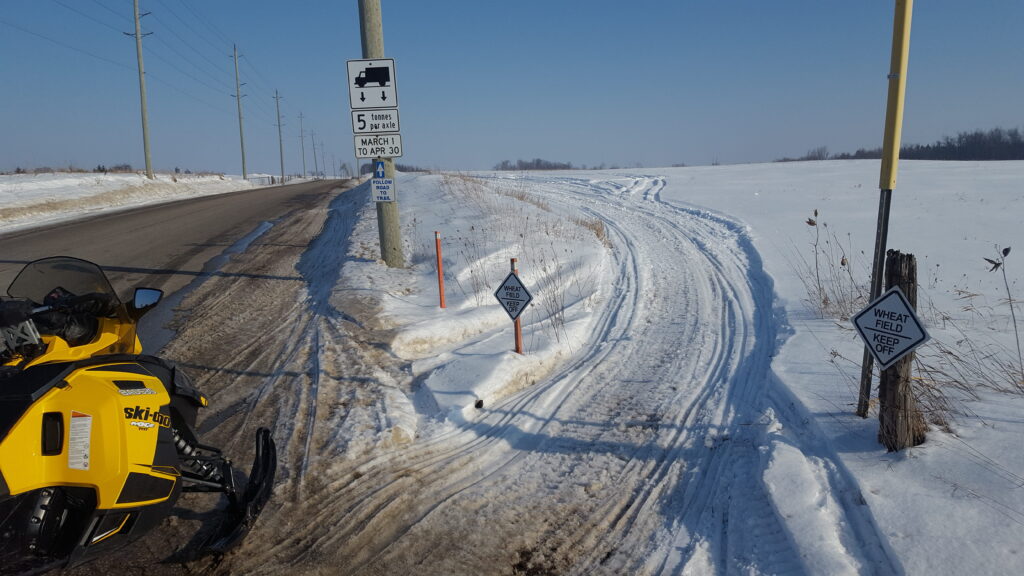
Despite warning signs, riders illegally entered this field to avoid road running. Photo by Graham Snyder
I’m sick of snowmobilers causing trail closures. How? While supposedly trail riding, they cut corners in farmer’s fields, ignore stake lines, run stakes down and stray off the designated trails to play in the snow. Or they ride beside the trail, take unauthorized shortcuts, enter closed areas, damage crops or harass livestock. Or ride with pipes loud enough to be heard in the next county.
Riders who engage in these unacceptable behaviours are basically thumbing their noses at everything the rest of us love about snowmobile trails. I’m angry that we’re constantly losing trails because of these self-centred off-trail behaviours. And I’m upset at the selfish disrespect it demonstrates towards landowners and club volunteers. Snowmobile clubs, fellow snowmobilers and organized snowmobiling in general suffer the dire consequences.
Permission To Stay On Trail
These disrespecters just don’t get it. They don’t care that snowmobile trails cross someone else’s land. These riders disregard all the effort and cost invested by clubs and volunteers on the trail. They ignore the fact that the trail exists only on the understanding with landowners that snowmobilers will stick to riding within that designated corridor.
This specified land use is not permission to ride willy-nilly over private property wherever and whenever you want. That’s called trespass. And when it happens, small wonder that all too often the outcome is permanent trail closure.
Where Trails Came From
Believe it or not, there was a time with no snowmobile trails. The original snowmobile clubs didn’t start building and organizing the first scattered and disconnected snowmobile trails for their members to ride until the 1960’s.
Over the past 60 years, these early offerings transformed into regional networks and then the 30,000-kilometre trans-provincial OFSC system we enjoy today. But if we keep losing trails at the current rate, we’ll regress rapidly back to the sixties, back to the days of having far fewer places to ride legally and safely.

What could be clearer than this? Thanks to whomever created this graphic.
Private Land Is The Backbone
In Ontario, over 60% of OFSC trails are on private land, owned by either individuals or corporations. Snowmobile trails exist because the property owners are willing to enter into a land use agreement to allow a designated corridor for snowmobile use only.
Even this dedicated usage is a problem. Far too many OFSC snowmobile trails are still being lost because other trespassing users, especially ATV operators, ride them in the spring, summer and fall, when they are shut down until the following winter. ATVs on snowmobile trails in the winter are an issue. But that’s another story for another time. Sadly, this one’s about snowmobilers deliberately and wilfully causing trails closures during the winter. Snowmobilers hurting snowmobilers.
As I said, 60% of OFSC trails are on private land. Certainly large areas of this private property are concentrated in Southern Ontario. But it’s not one solid chunk of land. Private ownership occurs in every OFSC district, in every part of Ontario. And trails on private property are the cement that holds together every part of the OFSC trail system – local, regional and provincial.
This means that the 40% or so of public land that OFSC trails cross is also heavily dependent on access to and from private land. So every section of private land trail that gets closed creates a ripple effect on surrounding trails, whittling away at their ability to remain part of the overall “system”.
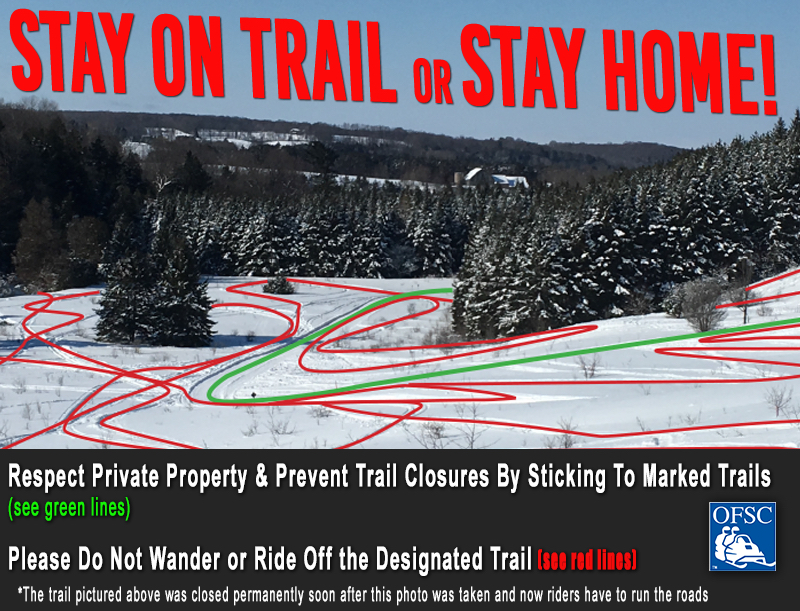
The Big Picture
It’s all too easy to miss this big picture damage. Typically, when a trail or section of trail closes, the most immediate impact is local. Snowmobilers in the area who previously used that closed trail frequently are upset and inconvenienced. The local snowmobile club has to deal with an angry landowner while also trying to find a workaround detour if available. One closure may also prompt other local landowners to reconsider a trail on their own land.
But make no mistake. The repetition of this local closure scenario across every part of the province is building like an invisible tsunami. And its leading edge is already eroding the underpinnings of organized snowmobile trails in Ontario.
Stay On Trail – Consequences of Trail Closures
Where exactly do these disrespectful trespassers think the replacement for a closed trail will come from? It’s not as if a snowmobile club can just snap its fingers and – presto! – a new trail magically appears. So today, our harsh reality is more closed trails. And that spreads an increasingly bad reputation for snowmobiling that sticks to each of us like the stink of fresh manure in a pasture.
So if we don’t get our act together now, what will our trail riding look like tomorrow? Here’s a glimpse. Read it and weep…
Fewer Places To Ride
One result will be fewer places to ride, more limited riding choices, and much more trailering. Anyone who enjoys early season riding, when many trails aren’t available yet, has already experienced trying to find available trails to ride. Except after early season riding, we can count on more trails opening as weather allows. But closed trails won’t open again, no matter how much snow Old Man Winter delivers. Back to the sixties!

Here’s the problem in a nutshell – ride between the stakes! Photo sourced from a Facebook post.
Broken Links
One of the primary benefits of our trans-provincial system is interconnectivity. We’re used to riding our snowmobiles on trails from community to community, region to region, border to border and even to connect with other provincial and state trail systems.
In many places, trail closures will put an end to these convenient links. We won’t be able to ride from here to there anymore. We’ll run into more detours and dead ends. Or we will have to ride a much longer route to get around a closure.
Pocket Riding
Another result of trail closures will be lots more of what I call “pocket riding”. Pocket riding happens when individual riding areas are cut off from one another, each as its own separate riding silo.
Many of these may be small pockets, perhaps several within a district with no trail access between them. Maybe still good for short day rides, but spelling an end to multi-day touring, weekend overnighters and probably even looping on circle rides like the OFSC Snow Tours.
Sound familiar? That’s because we had a taste of pocket riding last winter, sledding locally within our public health units thanks to COVID. Except that the COVID pockets were temporary. Pocket riding due to closed trails is permanent.
More Road Running
In many OFSC districts, there’s already been a significant increase in road running. Mostly, this is because of private property trail closures where no other alternative is available to re-connect broken trail links. It’s simple: more trail closures = more road running. And that means riskier riding, often on bare shoulders, increased wear & tear on sleds, and an overall less enjoyable experience.

Way too many signs like this all over the trails! Photo sourced from a Facebook post.
Grooming Issues
Groomers need trail access as much as snowmobiles do. Regardless of whether the trail that needs grooming is on private or public land, a groomer needs to be able to get to it. Normally, that involves using another trail.
In fact, grooming routes are planned and scheduled based on trail accessibility. Many remote trails can’t be reached except by other trails. Sometimes a groomer can get to a trail by road. But that can involve more risk, more wear & tear, and extra travel time that could have been used actually grooming another trail. So a trail closure often affects grooming operations. And that can lead to reduced consistency, quality and effectiveness. And a less enjoyable rider experience.
Volunteer Burnout
How angry and frustrated would you be if anyone at your job continually undermined your work, making you do it all over again? That’s what club volunteers experience every time a trail they’ve poured their hearts into gets closed because of riders not staying on the marked trail.
Now the volunteers have to take the time away from their other trail responsibilities to find, get permission for, and prepare a new route. To say nothing of the additional costs involved in creating a new trail. Plus, the permit dollars wasted on improvements already made to the now closed trail.

Volunteers instal tens of thousands of stakes each season to designate the trails.
Is this the thanks they get for their efforts? With only 6,000 volunteers to manage 30,000 kilometres of trail, how long do you think it will be before these unpaid club members start getting fed up and quit? Believe me, it’s already happening.
So how many of the 78% of snowmobilers that don’t volunteer are willing to step up to fill their shoes? If not, then who is going to prepare and maintain any remaining trails each season?
Fewer Services Available
Snowmobile clubs laid out the trail system so that riders could access services on route as easily as possible. When trail connections disappear, this access can become more difficult. Some businesses and even communities may also be cut off from their winter livelihood. When enough trails get closed, spending by snowmobilers will dry to a trickle in some areas. The mom ‘n’ pop businesses that depend on snowmobilers to help keep them open in winter will take a hit. That results in shorter business hours, fewer days open, loss of winter jobs and even business shutdowns.
Organized trails are the number one recreational generator of winter economic impact for many snowbelt communities. So trail closures will not only adversely affect riders look ing for services, they will also be bad for snowmobiling tourism and overall community prosperity.

More Trespass
Snowmobile trails came into existence way back when for two primary reasons. One, because snowmobilers wanted safe, legal places to ride. And two, because neighbours and communities were fed up with riders randomly trespassing on their property.
Strangely, we’ve come to a point where much of the trespass that is closing trails today occurs from the trails we are riding. Today’s trails are giving irresponsible snowmobilers access to areas where they wander off the designated trail. So landowners react by revoking land use permission and closing the trail. Problem solved?
I doubt it. My take is that closed trails may actually increase incidents of trespass as many snowmobilers look for alternative places to ride. That’s what happened before trails existed and I don’t think closing trails will end the rampant disrespect for private property.
In fact, when a trail that’s been there for years abruptly closes without a convenient replacement, do we really think the interlopers will suddenly have a change of heart and stop riding where that trail was? Or anywhere else they want? A solution like hefty trespass fines of $1,500 for first charge and doubling for each charge after that is a more likely deterrent. Or sled impounding. But only if trespass is strictly enforced.

What’s next, concrete barriers? Photo sourced from a Facebook post.
More Risk & Liability
Fewer trails to ride also means riskier snowmobiling. And you can bet that an insurance industry already skittish about the rising cost of snowmobile-related claims, will at best raise sled premiums, perhaps unaffordably. At worst, insurers will stop offering sled coverage altogether.
But it doesn’t stop there. Higher risk could also threaten the ability for the OFSC to continue to obtain trail liability coverage for its trails, clubs, volunteers and landowners. And if that happens, then there won’t be any trails at all.
Snowmobiling Will Move North
Without a doubt, Southern Ontario has the highest share of private property trails to lose. So combined with changing weather patterns, trail riding in many OFSC agricultural districts is the most vulnerable if trespass-related trail closures continue. On the other hand, Northern Ontario has a larger percentage of Crown Land and more certain winters. So another long term consequence of too many trail closures is that Ontario trail riding will move north.
But who will pay for it, when permit revenues drop off? A strong possibility given that the majority of permits are currently sold in Southern Ontario and fewer trails there could mean lower sales.
That isn’t to say that pocket riding won’t be available in scattered southern areas, but snowmobiling as we know it today is more likely to survive farther north. So get your trailers ready and watch out for increased traffic on the trails!
Stand Up & Be Counted To Stay On Trail
I’m not so naïve as to expect that any trespassers will read this rant. Or react with anything but oblivion if they do. I know I’m preaching mostly to the converted.
But nodding your head in agreement with what I’m saying isn’t enough anymore. The integrity of our snowmobile trail network is gradually slipping through our fingers like powdery snow. Enforcement agencies don’t seem to have the resources, inclination or time to help.
So the majority of so-called responsible snowmobilers must step up and start self-policing against the trespassers. Otherwise, a time will soon come when taking action won’t matter anymore because it will be too late. Many trails will be gone forever.
Before you know it, we’ll be sitting around reminiscing about the good old days. That not so distant past when we could snowmobile directly from community to community by trail. When we could actually get from here to there easily on designated corridors. Or when, for clubs and volunteers, delivering snowmobile trails wasn’t so fraught with uncertainty, frustration and ill will. And when the snowmobiling community had a better reputation with our landowning neighbours.
Stay On Trail – Not About Backcountry Riding
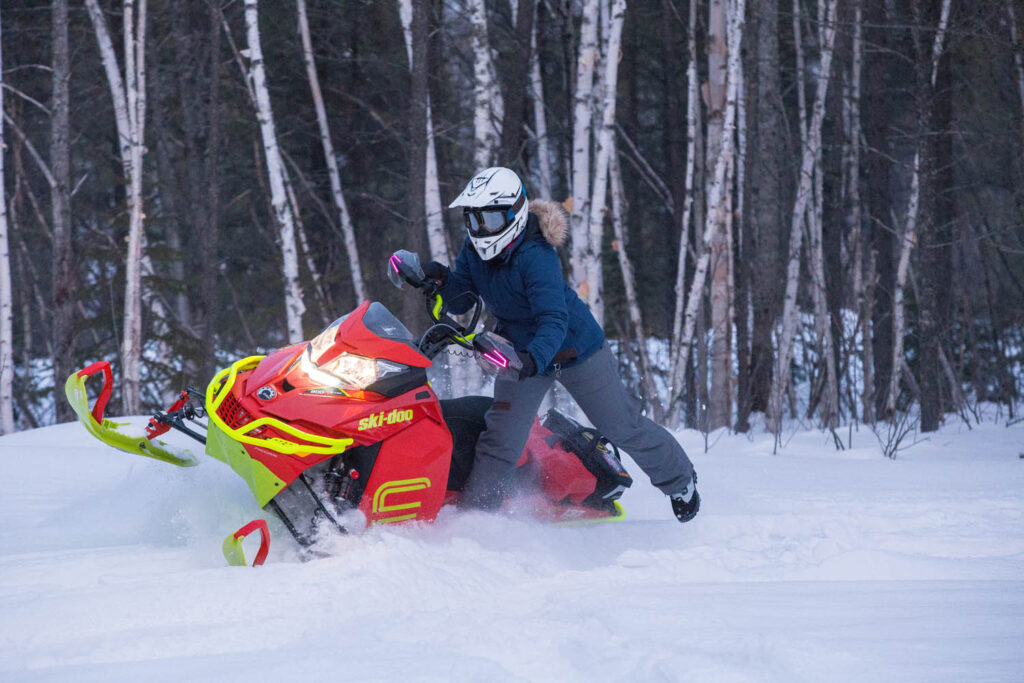
Backcountry riding on public lands is different than wandering off trail on private property. Photo courtesy of Ontario Tourism.
Don’t get me wrong. This tirade isn’t directed against legitimate backcountry riders. These are riders who travel into the boonies away from snowmobile trails to play in the powder on public lands where it’s legal and allowed.
Rather, it’s targeted to wanna-be powder hounds on private property. Sledders whose self-serving substitute for legitimate backcountry riding is straying on and off or riding beside designated snowmobile trails. Or simply entering a piece of private property to ride without prior permission from the landowner. All for the purpose of laying fresh tracks across unmarked fields or in virgin snow on land they don’t own and aren’t supposed to be on.
To these disrespecters I say: Stay On Trail or Stay Home!
And the rest of us need to act to help them do just that. Why? Because the consequences of their unacceptable behaviour has irreparable consequences. Like fewer trails for the rest of us to enjoy, unnecessarily longer distances to ride, and serious road running safety concerns. Plus, more wear & tear on our sleds. And overall, a less pleasant ride experience. To say nothing of contributing to the long-term demise of trail riding as we know it.
Stay On Trail Declares War on Trespassers
What Snowmobilers Can Do
How do we declare war on trespassers? By always ensuring that we stay on trail ourselves and making sure our families and friends do too. By calling out anyone in our group who doesn’t. And by refusing to ride with anyone who’s a habitual offender. Do our part to make trespassing off the marked trail socially unacceptable in the snowmobiling community. Follow the OFSC Code of Conduct for Trail Riders.
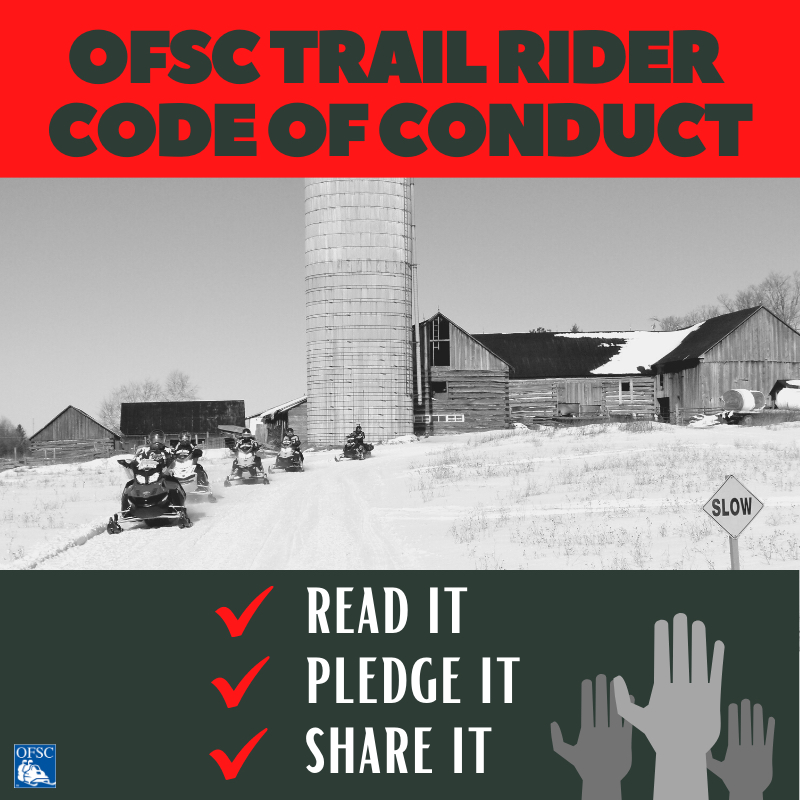
We can also take photos of identified disrespecters, posting them online and emailing them to the local club. Or take exception to anyone posting text or photos online depicting trespass behaviour. And yes, even by issuing the challenge when necessary to “Stay on trail or stay home.”
And let’s not forget the new generation of snowmobilers. Every snowmobiling family needs to teach their children why it’s important to stay on trail. And if you know any of the many newbies that are participating for the first time this season, please ask them to read this article before you ride with them.
What The OEM’s Can Do
Each snowmobile manufacturer also needs to do its part independent from what’s done collectively through their industry association. Increasingly, with the marketing of “crossover” sleds, their promotions are blurring the line between acceptable and unacceptable riding behaviour around snowmobile trails.
Sure, they want to sell sleds to the backcountry market, but they also need a strong reminder that without trails to ride, the size of the snowmobile market will shrink dramatically, affecting their bottom line.
For many of us, snowmobile trails are still the most popular place to ride their products and the manufacturers need to be very careful in their advertising, brochures and websites to support our trail networks and respect our landowners.
I’m pleased to see that the OEM’s stepped up this year with their Take The Pledge initiative:
What The Media Can Do
Same goes for the snowmobile media. The magazines, television programs and websites that live and breath snowmobiling must become active participants in promoting Stay On Trail or Stay Home. And media photos, editorials, articles and advertising need to unequivocally support that position when it comes to trail riding. The media need to help educate riders about why everyone should stay on trail. Like Supertrax Magazine did recently.
What The OFSC Can Do
As the lead voice for organized snowmobiling in Ontario, the OFSC needs to take a proactive lead on the trespass issue. It is already delivering the Stay On Trail message to snowmobilers through various social medIa platforms. But it should also be working closely with agricultural groups, the Ontario Trails Council, and other stakeholders to lobby government for immediate legislative relief.
These changes could include addressing potential solutions like higher trespass fines, impounding trespasser sleds, and better trespass enforcement. Other ideas to consider include tax rebates for landowners with trails, change to liability laws to reduce landowner (and volunteer) exposure, refusal of trail permits to trespassers, crop damage reparations, and permanent designation of key trails.
Whatever it takes, the OFSC needs to be front and centre, leading the charge as it has with its Save Our Trails Campaign and Stay On The Trail video:
Stay On Trail Last Word
In recent years, drinking and driving have become socially unacceptable. Breathing second hand smoke has become a no-no. Now it’s time for the snowmobiling community to stop tolerating abuse of private property by making straying off any snowmobile trail socially unacceptable too. We also need to ensure that novice trail riders get the message (and also read my snowmobile beginners tips).
Unless we declare war on trespassers now, I fear we’re doomed to be riding snowmobile trails that disappear out from under us like snow melting in the spring. And that’s certainly not a future I want to contemplate. What about you?
The tips and advice in this blog are the opinions of the author, may not work in every situation and are intended only for the convenience and interest of the reader, who has the personal responsibility to confirm the validity, accuracy and relevancy of this information prior to putting it to their own use.


